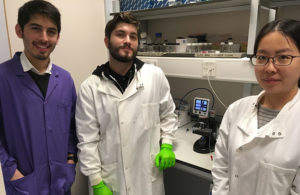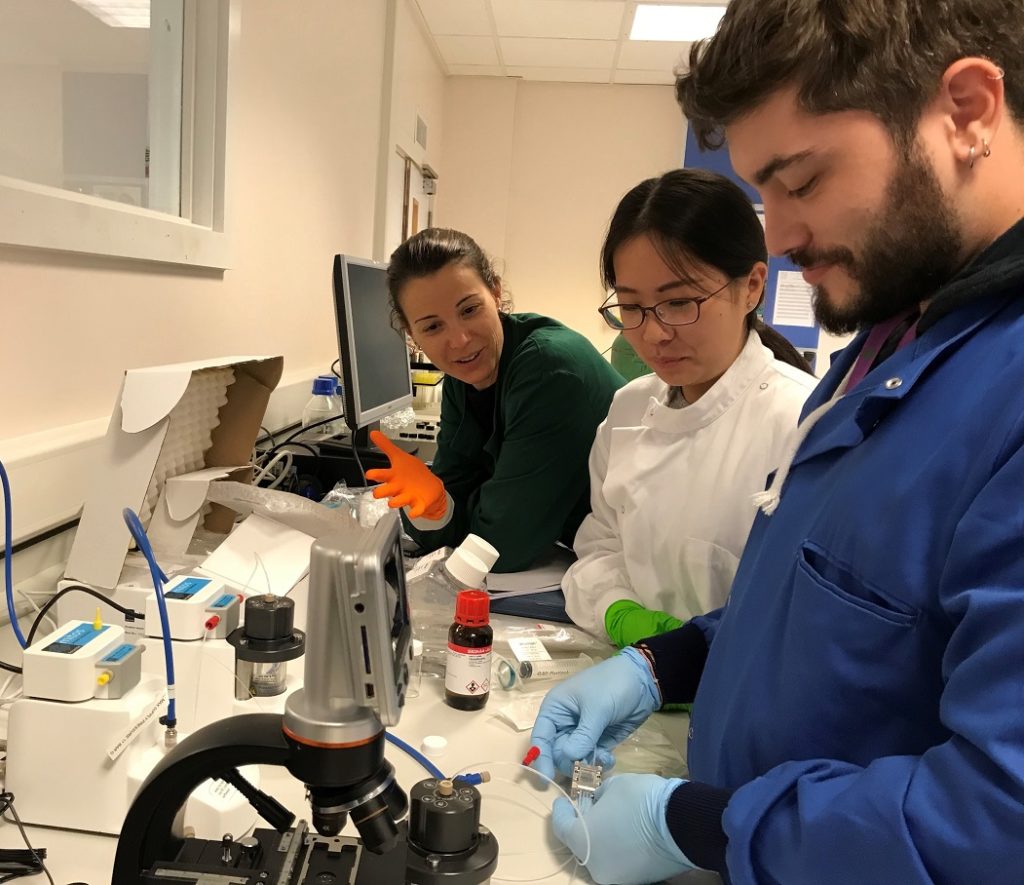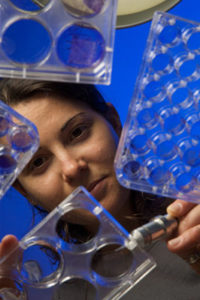
Traditional methods for drug encapsulation are limited in their ability to fabricate consistently sized, monodisperse liposomal formulations. As a result, they can negatively influence the efficacy of therapeutic drug delivery. More efficient manufacturing methods and microfluidic technologies provide an alternative, high throughput and cost-effective approach to producing nanotherapeutics. Researchers at the University of Manchester are currently optimizing an automated microfluidic set-up from Dolomite Microfluidics to learn more about the production of liposome formulations, potentially transforming the future of drug encapsulation.
The nanoencapsulation of drugs can help prevent the early inactivation or dilution of a compound, offering the potential for controlled, localized or sustained drug release. Nanoencapsulation can thus support pharmaceutical applications ranging from topical treatments to chemotherapy. The technique can also help stabilize therapeutic compounds, prevent adverse side effects from burst release and improve the in vivo dispersal at the target site. Diffusing therapeutics at the desired destination is extremely important in applications such as chemotherapy that use potent and cytotoxic chemicals to attack cancerous cells. Ideally, a drug delivery method should limit this toxicity elsewhere in the body.
Liposomal formulations are the ideal versatile nanosized vehicle for encapsulating and carrying various active pharmaceutical ingredients (API). They can entrap hydrophilic solutions in their internal aqueous core and intercalate hydrophobic elements in their phospholipid bilayer. Liposomes come in all shapes and sizes, with varying lamellarity, membrane composition and charge. These traits can determine their in vivo behavior and efficacy as nanocarriers. The first liposomal delivery systems comprised an aqueous core enclosed by a lipid bilayer consisting of cationic, anionic or neutral lipids and cholesterol, but these were susceptible to premature opsonization and elimination from the bloodstream.1 More recently, researchers have used inert polymers such as polyethylene glycol (PEG) to functionalize sterically stabilized liposomes with greater therapeutic efficacy.2 For example, PEGylated liposomes were a vital component in producing the COVID-19 mRNA vaccines from Pfizer-BioNTech.3 Therefore, the liposomal formulation – including the chemical composition, size and stability of particles – can play a significant role in therapeutic efficacy. More emphasis is required to ensure that manufacturing methods can guarantee the production of monodisperse and uniform structures.
Improving encapsulation efficiency
The successful delivery of drugs depends largely on its drug carrier and delivery route undertaken. No matter how novel and powerful the drug is, if it is poorly delivered and there is no drug released at the intended target area, it will result in a lot of loss in research and development of the drug.
Conventional liposome preparation methods rely on batch production techniques such as sonication, homogenization and membrane extrusion, including thin-film hydration methods. But these procedures are often characterized by high batch-to-batch variability, unreliable particle dispersion and poor size distribution. This fact often leads to significant wastage and low particle yields. Multiple size-selection processes are needed downstream to filter out the useful liposomes from the rest of the batch. However, microfluidics offers a continuous and high throughput production method for liposomes that can overcome the limitations of batch-to-batch variability. With microfluidic technologies, scientists can define parameters for precise control over fluid flows to produce monodisperse liposomal formulations with consistent size and shape, eliminating the post-modification size-selection stages to improve encapsulation efficiency.

Fabricating monodisperse liposomes
Researchers at the University of Manchester have taken advantage of an automated system from Dolomite Microfluidics to optimize liposome formulations and fabricate PLGA drug delivery systems for oncological and pharmaceutical applications.4 Using a microfluidic chip and pump device, they synthesized a liposomal formulation co-encapsulating water-soluble doxorubicin in the core with lipophilic umbelliprenin in the lipid bilayer. Doxorubicin is a potent cytotoxic agent used in the chemotherapeutic treatment of breast cancer to attack malignant cells, and umbelliprenin demonstrates powerful anti-inflammatory and anti-tumor capabilities to complement the treatment. Scientists compared the size, structure, stability and toxicity of the liposomal formulations produced with microfluidics to the equivalent formulations made using conventional thin-film hydration methods.
The researchers found that the microfluidic-based liposomal formulations were more homogeneous in size and structure and demonstrated enhanced toxicity to breast cancer cell lines that could provide greater therapeutic efficacy. The liposomes produced from microfluidics and thin-film methods were comparable in size, stability and drug loading capacity (>30 %); however, microfluidics offered greater control over environmental parameters by adjusting the flow of fluids to provide a reliable and autonomous method of manufacturing. Researchers could easily alter the liposome size by amending the organic phase composition, total flow rate or flow rate ratio to achieve morphological and size homogeneity across the formulations. The researchers also found that the addition of umbelliprenin unexpectedly increased the stability of the particles, the homogeneity of particle size and the therapeutic efficacy of the treatment, which is hypothesized to be a result of varying kinetics.
Future research
Microfluidics provides high throughput and a continuous method for producing monodisperse, unilamellar liposomal formulations for use in nanomedicine to overcome the limitations of current, suboptimal methods. Researchers are now using microfluidics to further understand the process of autonomous liposome production and optimize the fabrication method for various particles and model drugs across other biopharmaceutical applications, transforming the future of efficient and reliable drug encapsulation.
References
- Hua S, Wu SY. The use of lipid-based nanocarriers for targeted pain therapies. Frontiers in Pharmacology. 2013 Nov 21;4:143.
- Sercombe L, Veerati T, Moheimani F, Wu SY, Sood AK, Hua S. Advances and Challenges of Liposome Assisted Drug Delivery. Front Pharmacol. 2015;6:286. Published 2015 Dec. 1. doi:10.3389/fphar.2015.00286.
- Pfizer. The Facts about the Pfizer-BioNTech COVID-19 Vaccine. Pfizer website. 2021. Accessed 14th June, 2021.
- Gkionis L, Campbell RA, Aojula H, Harris LK, Tirella A. Manufacturing drug co-loaded liposomal formulations targeting breast cancer: Influence of preparative method on liposomes characteristics and in vitro toxicity. International Journal of Pharmaceutics. 2020 Nov 30;590:119926.

Annalisa Tirella is a lecturer at the University of Manchester. Annalisa started her research for the design and manufacturing of in vitro models for tissue engineering and regenerative medicine since her bachelor thesis in bioengineering at the University of Pisa, developing a microfluidic bioreactor for toxicology drug screening and designing 3D cell laden hydrogel mimicking hepatic biomechanical cues. In 2011, she receive her Ph.D. with the thesis titled “Development of a modular microfabrication system to engineer complex tissues” at the University of Rome. In 2012, Annalisa joined the Institute of Clinical Physiology of the Italian National Research Council as post-doctoral research fellow, working on a FP7 project aiming at the characterization of materials to engineer soft tissues. In 2014, Annalisa joined the University of Manchester as research associate, being appointed as Lecturer in Pharmaceutics with the School of Pharmacy (University of Manchester) few months after.
 Gurinder Vinner is a senior applications scientist working for Dolomite Microfluidics. She is responsible for the brand’s applications activities with a keen interest in discovering novel ways of applying microfluidics.
Gurinder Vinner is a senior applications scientist working for Dolomite Microfluidics. She is responsible for the brand’s applications activities with a keen interest in discovering novel ways of applying microfluidics.
She has a background in Microbiology and a Ph.D. in chemical engineering, enabling her to bridge gaps between different disciplines. Her experience in encapsulation of phages for pharmaceutical, food and agricultural industry allows her to understand formulation development challenges and the use of micro- and nanoparticles for targeted delivery.

